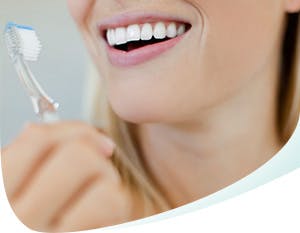
What Color Should Tooth Enamel Naturally Be?
Modern media has made us believe that a bright white smile is a sign of healthy, strong teeth. There are whitening toothpastes, strips, pens, rinses and all manner of products designed to make your teeth look a different color than they are. But what color are your teeth supposed to be?
We spend lots of time worrying about the state of our enamel and how our smile looks, but we should take a minute to understand what determines the color of our teeth, and the true color of tooth enamel.
What Color is Tooth Enamel?
Your teeth are made up of four different dental tissues. Three of them are enamel, dentin and cementum, and enamel thickness and dentin most directly contribute to the color of your teeth.1,2
Your enamel consists of hard tissue on the outside of your tooth that is composed of minerals. It does not contain any living cells and cannot self-repair any damage from decay or wear—which is why it’s so important to protect it and properly care for it. It functions to protect the dentin, which is softer and located under the enamel.1
Even though enamel is on the outside of your tooth, it’s semi-translucent.2 Instead, the layer of dentin underneath is what supplies the color for your teeth; it can vary from grayish-white to light yellow and everything in between and still be considered healthy.2 While the shade of your enamel plays a role, the color of your dentin is what ultimately determines the color of your teeth.2
Why Do Teeth Become Discolored?
Having a bright white smile is a goal that many people hope to achieve. While some are in it for the aesthetics, others may do so because they believe that their teeth are unhealthy.2
Yellowing teeth may mean that your enamel is thinning due to acid erosion, making your dentin more visible. Since enamel cannot repair itself naturally, you’ll need to talk to a dentist about a plan for remineralization.1 One way you can help remineralize your enamel at home is to use a toothpaste that’s specially formulated for enamel repair. Try Pronamel Intensive Enamel Repair Extra Fresh Toothpaste, which features Pronamel’s most advanced enamel care formulation.
There are a host of reasons why your teeth may become discolored. Some of them are unavoidable, like genetics and aging.3 Some people have naturally thin enamel: as we age our enamel becomes thinner, showing more and more of the dentin beneath.3 In other cases, certain diseases and medications can be responsible for tooth discoloration.3 Adults who took certain antibiotics, such as tetracycline, as children may have tooth discoloration through no fault of their own.3
Some tooth discoloration such as staining is avoidable. If you’re a smoker, you should try quitting as research has indicated that discoloring is more common among those who use tobacco.3 If your diet is full of things that stain your teeth like coffee, wine, and berries, your teeth may take on discoloration.3 Poor oral hygiene is responsible for tooth discoloration, as stains stick to the plaque on your teeth.3
What Do Different Tooth Colors Mean?
If you’re experiencing tooth discoloration from staining, the color itself may point to the cause of the issue:3
- Brown stains are the result of using tobacco.
- Purple stains can usually be traced to those who consume a lot of wine.
- Gray discoloration may be indicative of dental trauma that’s affected the nerve inside the tooth.
- White spots on a tooth may indicate fluorosis, which is an overconsumption of fluoride during childhood.
- Yellow stains might mean you’re consuming a lot of foods that stain your teeth like soy sauce or coffee. It could also mean you’re not cleaning your teeth well enough.
If the color of your teeth is causing you concern, talk to your dentist about the reason for the discoloration and what can be done about it. In the meantime, care for your enamel at home with a specialty toothpaste like Pronamel Active Shield Fresh Mint Toothpaste.
Source Citations :
- Tooth – The Anatomy of a Tooth. Mouth Healthy. https://www.mouthhealthy.org/en/all-topics-a-z/tooth. Accessed 6/27/23.
- Tooth Enamel. Cleveland Clinic. https://my.clevelandclinic.org/health/body/24798-tooth-enamel. Accessed 6/27/23.
- Tooth Discoloration. Cleveland Clinic. https://my.clevelandclinic.org/health/diseases/10958-tooth-discoloration. Accessed 6/28/23.



